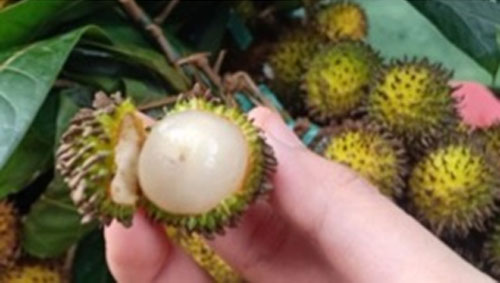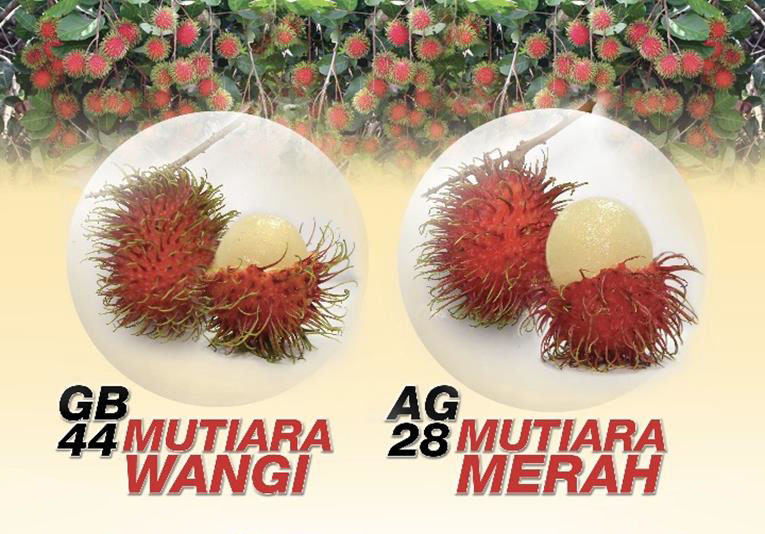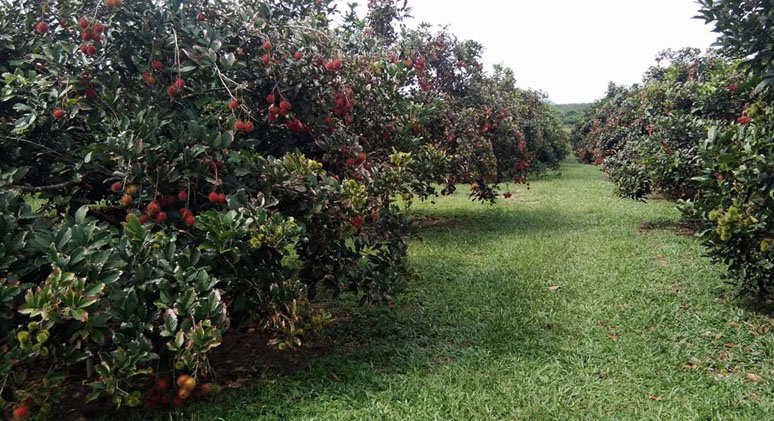Rambutan (Nephelium lappaceum Linn) belongs to the Sapindaceae family which also includes litchi, longan and pulasan. It is believed to be native to Malaysia and popularly grown in other Southeast Asian countries including Thailand, Indonesia, Philippines and Cambodia. The fruit is also grown on smaller scale in Mexico, Sri Lanka, India, Australia, Central America (Mexico) and South Africa.
There has recently been interest in developing the fruit further as it possesses market appeal due to its size, unique appearance, and taste. While Thailand leads in its production and trade, other countries in the region are also stepping up efforts to seek for superior high yielding cultivars for domestic and export markets. Currently Thailand and now joined by Vietnam export the fruit to China and other southeast Asian countries, while Mexican exports are mainly to the US market. Malaysia exports the fruit to Singapore and Brunei.
Rambutan, a common minor tropical fruit in Southeast Asia has been touted as having good prospects to be developed into a globally accepted and consumed fruit. There have been considerable efforts by producing countries to increase production, improve existing cultivars, improve field and postharvest practices, pests and disease management, and develop export protocols for the fruit. The current state of production and consumption was discussed in an international webinar on ‘Enhancing global consumption and trade of rambutan’ organized by International Tropical Fruits Network (TFNet) and the Malaysian Department of Agriculture on 18 May 2023.
The aim of the webinar was:
- To share information among stakeholders on the various initiatives to increase rambutan production and markets, including cultivar development, best farm practices, postharvest management, inputs for the food industry, research and development focus and policies to encourage its cultivation.
- Gauge the current scenario and deliberate on the potential of rambutan as another globally popular and traded fruit.
Four speakers from China, Indonesia and Malaysia discussed the current situation of rambutan development in the Asia Pacific region.
Mr. Christopher Biai, Director, Commodity Development Division from the Malaysian Department of Agriculture Malaysia, in his presentation ‘Rambutan cultivation and Market in Malaysia’ reported that the total area of rambutan in the country is currently about 14,700 ha., which is about 7.6 %of the total fruit area, and with an average production is about 4.0 mt/ha. He also reported that Malaysia is 99.4 % self-sufficient in rambutans, with exports of only 3.2 % of total production in 2021 mainly to Singapore and in smaller amounts to Brunei. Malaysia also imports substantial amounts from Thailand. The Malaysian Agricultural Research and Development Institute has recently introduced two new cultivars, AG28 (Mutiara Merah) and GB44 (Mutiara Wangi) to add up to the older but popular varieties such as R191 or ‘Anak Sekolah’ (similar to Rong Rien from Thailand) R170 or ‘Deli Cheng’ and R 162 or ‘Oh Heok’. The domestic market has been static for the past few years, notwithstanding, the Department of Agriculture Malaysia has included rambutan as one of the priority fruits to be developed in the 12th Malaysia Plan. This follows the greenlight to export the fruit to US, and the successful mock trials conducted to satisfy the requirements for export, including identifying farms with MyGap certification, proper postharvest practices, packaging and radiation treatment for biosecurity purposes.
Dr. Meiying He from South China Agricultural University, Guangzhou, China, in her presentation, ‘Market Potential Analysis on Rambutan in China’, said that China is a net importer of rambutan, most of it imported from Thailand. Thailand is a big producer of rambutan but exports only 6.2% of total output. The fruit is also produced in Hainan, China, but production is low, resulting in insufficient market supply. According to Dr. Meiying the market recognition of rambutan in China is still low, however the market price compared to other fruit types, is relatively high. The main constraints being the storage and transportation challenges, limited production area, inadequate market scope plus the high perishability of the fruit. Currently the market for rambutan in China is still limited and it needs more time to be developed into a choice fruit for consumers.
Even though production increased 1.5 times in Indonesia in the last five year, rambutan consumption was ranked 6th in 2021, compared to other fruits like banana, papaya, citrus, salak and watermelon. Prof. Dr. Sobir, from the Centre for Tropical Horticulture Studies, IPB, Indonesia added that even though there are many good cultivars in the country, demand remains slow and has declined the last few years. He attributed this to young consumers’ choice of ‘convenient or easier’ already peeled fruits, mixed cropping backyard cultivation system and consumer options for other fruit types. However, the fact that fruit has in the past been exported to countries in the Middle East, Singapore, Europe and USA, indicates that there are still good prospects for it to be developed, especially with less perishable cultivars such as the ‘Rapiah’ variety.

There has been cultivar improvement work done in Malaysia to enhance the appeal of the fruit. Starting from seedling plants and selected grafted plants for evaluation, Dr. Johari Sarip, a fruit breeder managed to screen the many diverse progenies that were selected.
In his presentation on ‘Breeding and Varietal Improvement of Rambutan (Nephelium lappaceum Linn) in Malaysia’, he said, after years of screening for characteristics including yield, total soluble solids content, tree and fruit size, time of first flowering, detached testa, seed size and pest and disease tolerance, two new cultivars, the AG-28 and GB-44 were successfully developed. These new cultivars are now being produced and distributed and it is envisaged this will catalyse and improve rambutan production and market in Malaysia.

It is apparent that rambutan needs more focus and efforts for it to be developed into a globally accepted fruit. Gauging from the market in the last few years, consumer demand in the Asian region has been lukewarm and slow and the market stagnant. This is also observed in the Chinese market for rambutan, which seems to be saturated as for now.
There needs to be continuous efforts to encourage consumption of rambutan as a healthy and safe fruit and make it more convenient for consumption.
There are already efforts by FAO to have separate HS codes (Harmonised System) for minor fruits including rambutan, however, this also depends on the trade quantum for these fruits. Aggressive promotion for the fruit is required to improve production and markets.
Consumer demand is complex and unpredictable especially for a ‘new’ fruit type, but with the production of clean, safe, nutrient dense and new attractive cultivars, plus aggressive promotion, and most importantly postharvest technologies and practices, that can extend shelf life, it is anticipated that the popularity of rambutan can be enhanced. Taking the example of other minor fruits such as the pitahaya or dragonfruit, which took many years to become popular and that countries like Malaysia and Indonesia have added rambutan as one of their focus fruits to be developed in the coming years.
While its development remains slow compared to other minor fruits, there is still potential for rambutan, considering future markets in Asia, the Middle East and Europe based on demography and the anticipated increase in consumption and exports due to, the diaspora of Asians to other countries for work or migration and trade negotiations among export and importing countries.

